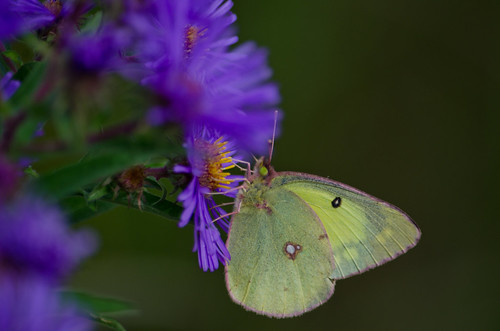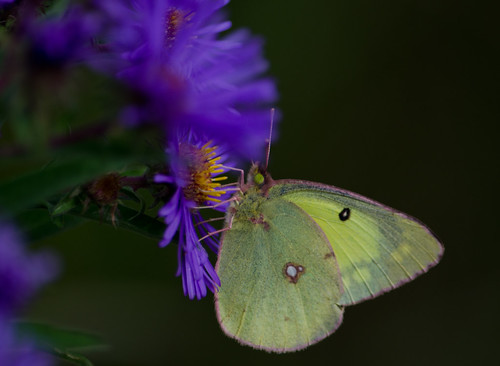


Donate Now
and become
Forum Supporter.

Many perks!
<...more...>


|

09-28-2013, 10:28 PM
|
 |
Moderator
|
|
Join Date: May 2005
Zone: 7b
Location: Queens, NY, & Madison County NC, US
Age: 44
Posts: 19,374
|
|
 Need comments on my latest picture
Need comments on my latest picture
Thought the colours were good in this pic, but the grainyness of the picture left me a bit dissapointed.
Any comments? Whish I had a lens that took in more light.
THanks.
 Orange Sulphur
Orange Sulphur by tindomul1of9, on Flickr
 Orange Sulphur
Orange Sulphur by tindomul1of9, on Flickr
__________________
"We must not look at goblin men,
We must not buy their fruits:
Who knows upon what soil they fed
Their hungry thirsty roots?"
Goblin Market
by Christina Georgina Rossetti
|
|
Post Thanks / Like - 9 Likes
|
|
|
|
|

09-29-2013, 08:24 AM
|
|
Senior Member
|
|
Join Date: Jul 2011
Zone: 6b
Location: Springfield,MO
Posts: 830
|
|
Love those colors!...Jean
|

09-29-2013, 08:33 AM
|
|
Senior Member
|
|
Join Date: Sep 2006
Zone: 10a
Location: Geelong, Victoria
Age: 56
Posts: 2,479
|
|
Looks pretty good to me, it doesn't seem too grainy. What kind of camera is it?
I would be really happy with those photos.
|

09-29-2013, 12:16 PM
|
|
Senior Member
|
|
Join Date: Jul 2008
Zone: 8a
Location: West Midlands, UK
Age: 49
Posts: 25,462
|
|

Looks good to me as well.
I've seen far more grainy pictures. The butterfly and the flower immediately near it look fairly sharp.
The rest of the flowers and the background 'fuzziness' looks to be down to depth of field. Looking at the camera settings in the picture meta data in Flickr, with f/5.6 it's quite a shallow depth of field. 1/800 shutter speed is quite fast so you should be able to go to something like f/8 which would give 1/400 shutter speed in identical conditions and give a bigger depth of field with more in focus.
However the low depth of field makes the butterfly 'pop' out the picture so I always find it a toss up of how deep/shallow I want to take it.
With a 300mm lens did you have to crop much? How much you can crop without graininess depends on the quality of the lens optics, as well as the sensor, however because of the sharpness to the flower near the butterfly I don't see this picture as grainy.
Another thought is that most lenses have a 'sweet spot' for clarity, which is not necessarily at the lowest f-stop. And finally ISO makes a big difference, but it's pretty low in this picture. Each camera has a maximum ISO which is not grainy and there are ways to test what that is on your camera. On our camera we can set the maximum the 'Auto' ISO will go, so we've set that to be only the ones we know are non-grainy so that we only go to the higher ones when we choose to, not on the auto setting.
Just some thoughts, hubby is the one who knows more than me about getting the best of of the camera.

|
|
Post Thanks / Like - 2 Likes
|
|
|
|
|

09-29-2013, 12:54 PM
|
 |
Senior Member
|
|
Join Date: Jul 2013
Location: Colorado
Age: 44
Posts: 2,586
|
|
I love the colors and the butterfly. One criticism would be that I don't think the blurred flowers in the foreground do much for it. Behind the butterfly it would make it pop even more, but in front of it...
|

09-30-2013, 03:09 AM
|
|
Senior Member
|
|
Join Date: Jul 2010
Location: Los Angeles
Posts: 553
|
|

Nice image to start with. Shot with a Nikon D7000, so DX/APS-C format, so 300 mm lens is effectively a 450 mm lens. For my taste, the focal plane is a bit soft (I'm geeking out on crisp focal planes, and spend minor fortunes on Zeiss and L glass), which could have a variety of reasons:
- reading between the lines, you shot the 300 mm lens at f/5.6 all open, so that implies that it is not a top tier lens, which usually are f/2.8. It really makes a difference. It may even be a zoom at 300 mm, rather than a 300 prime, because 300 primes usually are f/4. Zooms have inherently worse optical quality than primes.
- Most likely, image is taken close to close focus limit of lens. Telelenses are optimized for infinity focus, so shooting with this lens at close up is already a compromise.
- As Rosie C has pointed out, usually lens' sweet spot for sharpness is 1-2 f-stops down from fully open; another reason to spend a bit more.
- I don't think there is motion blur, though at close up, that can quickly become a serious problem: slightest camera movement, mirror slap, slightest breeze. 1/800s does not sound unnecessarily fast to me, given the equivalent focal length and it being a close-up.
- Have been pondering a 180 mm macro for that very same reason. I currently use my 300/2.8 with extension tubes for venomous snake portraits and alike, not ideal either. But starting off with a higher quality lens will help a lot in non-ideal situations. I am wondering whether Sigma 180 macro has better quality than the Canon 300/2.8 with extension tubes. Unfortunately, the Zeiss 100 Makroplanar does not accept TCs.
In terms of composition, the front flower intrudes on the antennae. Moving to right or lower the point of view would solve that, but would also put the wing of the butterfly at an angle to focal plane. Tricky trade-off.
I would also brighten the image up a bit (spread tonal value across entire greyscale), easy to do during RAW/NEF conversion, or even with levels/curves if you shoot .jpg. That will make the butterfly pop much more. Be careful not to blow out the orange anthers in the sunflower. Then play with how much you may want to darken the background, either for the ultimate contrast, of to get pastel tone set-off. That is a matter of taste.

|
|
Post Thanks / Like - 2 Likes
|
|
|
|
|

09-30-2013, 11:02 AM
|
 |
Moderator
|
|
Join Date: May 2005
Zone: 7b
Location: Queens, NY, & Madison County NC, US
Age: 44
Posts: 19,374
|
|
Wow guys, thanks for all the help. Yes I am using a zoom lens, yes it was near the min focal distance, and yes its not a top tier lens. Nikkon DX AF-S Nikkor 55-300mm 14.5-5.6GED.
I have been reading about prime lenses, but my question is, how do they work? Do you always have to be at the right distance to get your subject in focus?
Rosie, I cropped it just a wee bit. Not much.
__________________
"We must not look at goblin men,
We must not buy their fruits:
Who knows upon what soil they fed
Their hungry thirsty roots?"
Goblin Market
by Christina Georgina Rossetti
|

09-30-2013, 12:15 PM
|
|
Senior Member
|
|
Join Date: Apr 2008
Posts: 6,386
|
|
Don't have a lot to add to what's already been said, but I do agree with what's been said, and I don't think I would have cropped it as closely especially at the bottom of the shot.
|

09-30-2013, 03:37 PM
|
 |
Moderator
|
|
Join Date: May 2005
Zone: 7b
Location: Queens, NY, & Madison County NC, US
Age: 44
Posts: 19,374
|
|
Neither would, but i didn't have too much space to work with at the bottom. Thanks all.
__________________
"We must not look at goblin men,
We must not buy their fruits:
Who knows upon what soil they fed
Their hungry thirsty roots?"
Goblin Market
by Christina Georgina Rossetti
|

10-01-2013, 04:36 PM
|
|
Senior Member
|
|
Join Date: Jul 2008
Zone: 8a
Location: West Midlands, UK
Age: 49
Posts: 25,462
|
|

Quote:
Originally Posted by Tindomul

I have been reading about prime lenses, but my question is, how do they work? Do you always have to be at the right distance to get your subject in focus?
|
No you can alter focus, but effectively have a fixed zoom/field-of-view. So to get closer you can't zoom... you have to walk towards the subject instead to get the framing you want.
Now hopefully the following will make sense and hopefully I've got it right, if not someone please correct me.
I think the confusion here is between focal length and focal/focusing distance. It confused me to begin with.
The focal length of a lens determines the field-of-view or 'zoom' of that lens. With a prime lens you can't alter the focal length so can't alter the 'zoom'. As I said above you can't zoom without walking towards the subject, or switching lenses.
It's not quite that simple though as tropterrarium mentions, a 300m lens on your camera actually gives the zoom/field-of-view of a 450mm lens on a full-frame sensor. I believe a full-frame DSLR sensor is based on a 35mm film SLR. So the image you get from a 300mm lens on a full frame camera should be the same as using a 300mm lens on a 35mm film SLR. Your camera, like mine, has smaller sensor which effectively crops the image, so the image you get has the same zoom/field-of-view as a 450mm lens on a 35mm film SLR. Generally speaking full-frame DSLR's are much more expensive though and used at the professional/semi-professional level.
Your focusing distance is how far from the camera sensor is in perfect focus. This can be varied in the usual way on a prime lens. Any lens will have a minimum focal length. Generally speaking they will also focus between that minimum and infinity (though there are some specialist exceptions).
A macro lens is a prime lens, but can generally focus closer than standard primes (to be called a macro there is also a requirement that on a full-frame sensor or 35mm film they can produce an image at least as big as it is in reality).
So, my 100mm macro can focus between 0.3m/0.99ft and infinity, while my 50mm prime can focus between 0.45m/1.5ft and infinity. If you are investigating particular lenses you should be able to get information on the minimum distance they can focus at.
As tropterrarium says primes are much sharper than zooms because they have simpler optics, also high end lenses do make a big difference as the glass is higher quality. Also don't forget filters and their quality, or extension tubes and their quality.
Anyway, Hubby and I found this article interesting explaining how different lenses work, if you are interested. Digital camera lens buying guide: Digital Photography Review

|
|
Post Thanks / Like - 4 Likes
|
|
|
|
|
|
Currently Active Users Viewing This Thread: 1 (0 members and 1 guests)
|
|
|
 Posting Rules
Posting Rules
|
You may not post new threads
You may not post replies
You may not post attachments
You may not edit your posts
HTML code is Off
|
|
|
All times are GMT -4. The time now is 06:50 PM.
|






































 Linear Mode
Linear Mode


